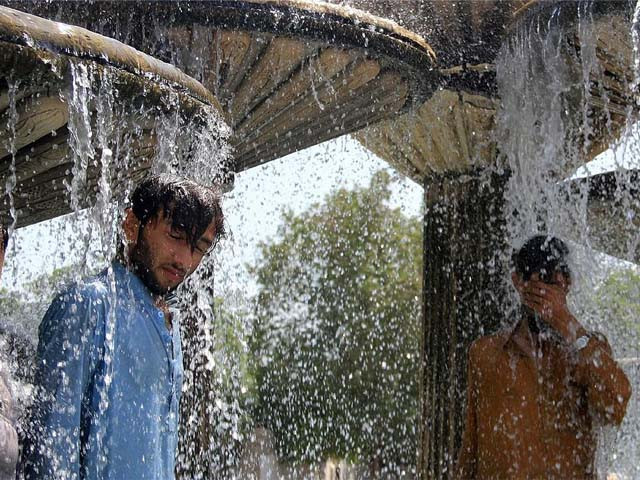Last Friday, the mercury climbed to nearly 40 degrees Celsius in Karachi. The Pakistan Meteorological Department had issued an advisory earlier in the week warning temperatures would rise after March 30, 2021. It’s hard to take a warning like that without a sense of impending dread. After all, it was only six years ago when a near apocalyptic heatwave claimed over 1,200 lives in the city. In the time since then officials have acted proactively to address future hot weather, with the Government of Sindh issuing a technical report in 2017 replete with actionable recommendations. But the question remains whether measures identified since then address the root causes of Karachi’s oven like atmosphere.
There are two ways of tackling the risks associated with urban heatwaves: management and mitigation. Karachi seems well prepared with the former. There exists, at least on paper, a comprehensive plan directing authorities what to do before, after, and during such an event. The plan, a collaborative product of the Karachi Commissioner Office, Government of Sindh, and LEAD Pakistan, emphasises the need to disseminate information about the risks of high heat. Additionally, it employs a three-tier alert system and creates response protocols for local agencies. The plan is both an attempt to raise awareness about seasonal heat and a roadmap for how officials and the public can respond to keep the city and themselves safe in the event of a heatwave. It is a thorough and vital management strategy that, if effectively applied, increases Karachi’s preparedness to deal with baking temperatures.
But management is a short-term solution. Mitigation strategies, on the other hand, aim to reduce how high the mercury can go in the future. A universally popular proposal to control urban temperatures here is greening – or planting trees and vegetation. The science is straightforward; green cover provides a natural canopy, improves air quality, benefits public health, and engenders a cool, well-regulated urban ecosystem.
But, while the logic behind urban greening is simple, its implementation in a city like Karachi may not be quite as straightforward. First, to be effective, urban greening requires space. Some studies estimate up to 50m2 of urban green space per person. In a city of 20 million were land is precious and expensive, that can add up – making large parks somewhat of a physical challenge to construct. There are other considerations as well. Though globally popular, urban greening has been associated with gentrification because it attracts high-income groups and drives up property values. In Karachi, this might further constrict access to housing. There is also the added risk that officials will resort to evictions to create space for green areas.
More likely, without a wide-scale overhaul in land use practices, greening, while important, may be limited to traffic medians and small-scale urban forests. The more immediate problem is that urban greening, when framed as a solution to climate change, elides the root causes of Karachi’s sweltering conditions. While it’s demonstrably true that Pakistan is getting hotter, how much rising temperatures affect a city is a function of manmade factors – not just climate ones.
Karachi is what experts call an urban heat island, a city that is warmer than its surrounding suburban and rural areas. This has nothing to do with its geographical nature; Karachi is not hot because of its location. Instead, it is the city’s built environment that attracts and traps heat. According to NASA, there are several factors that create a heat island including a lack of vegetation, population size, and development patterns. Understanding this means that a city’s temperature – though exacerbated by climate change – can also be a consequence of poor planning practices. Because human beings cannot control the climate, it stands to reason that mitigating urban heatwaves becomes a matter of instituting environmentally and people-friendly policies.
And this is where Karachi seems less prepared. First, there is currently no realistic transportation plan to solve the growing number of cars, motorcycles, and minibuses that choke the city’s thoroughfares. While underpasses and overpasses may ease the flow of traffic, they don’t reduce a dependence on private vehicles – a considerable source of heat. It is the latter approach that is proven to reduce urban heat. Second, Karachi’s obsession with building high-rise buildings continues unabated. As research shows, though tall buildings provide shade, they can prevent heat from escaping, leading to increased temperatures. And it isn't just shiny monuments like Icon Tower that are to blame here. A boom in “self-built” or informal high-rises – often as high as six or seven floors each – can also contribute to the urban heating effect. With constant urbanisation entrenching these problems, it’s no surprise the city becomes a veritable furnace during the summer.
Even so, there are initiatives officials can support to mitigate future heatwaves in Karachi. For instance, in addition to planting trees, planners may consider roof cooling strategies. Solar panels are a good bet here. When attached to roofs, they both absorb heat and produce efficient power. The good news is that solar power is already gaining some traction in Pakistan. The solution to traffic, meanwhile, might lie in taking small steps first – like encouraging ride-sharing – before embarking on dogged public transit projects like the Karachi Circular Railway and Bus Rapid Transit program. Again, there is plenty of emerging entrepreneurial activity in this sector that can be further incentivised.
These actions can begin to transition Karachi onto the path of long-term heatwave mitigation. But they cannot substitute for a partial understanding of the problem. Here, the immediate challenge lies in first identifying the multifaceted causes of Karachi’s urban heat, many of which are deeply entrenched in the city’s haphazard development patterns. As always, there are no easy-bake solutions in the City of Lights (no pun intended). It’s well past time we realised that.



COMMENTS
Comments are moderated and generally will be posted if they are on-topic and not abusive.
For more information, please see our Comments FAQ